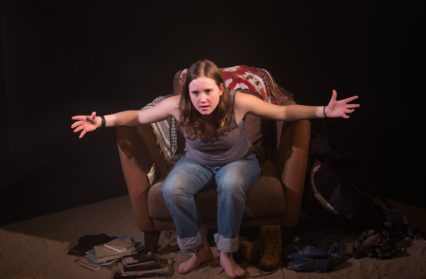Rachel Corrie was just shy of her twenty-fourth birthday when a bulldozer deliberately ran her down in Gaza. A brief yet extraordinary life took her from the quiet of Olympia, Washington to the war-torn border between Israel and Palestine and, as Graphic so tragically illustrates in its debut production, it should have been the beginning of a burgeoning career.
Details of her murder make up less than five minutes of Katharine Viner and Alan Rickman’s edited manuscript. This isn’t the story of a life cut unfairly short, but of a young woman trying to find home. As her own journals and emails attest, Corrie never felt at home in the suburbs of Washington. She found home amongst the bloodshed and the rubble, and arguably sealed her fate because of it.
My Name is Rachel Corrie is fuelled by provocation, sticking to a theme that has survived the change in regime at The Other Room. The last time Dan Jones and Chelsey Gillard teamed up, Constellation Streetwas lauded for its ambitious staging. This time, the ambition lies in the casting, and there is both merit and fault in the decision to give unknown commodity Shannon Keogh the lead role.
She certainly looks the part. As well as an uncanny resemblance to Corrie herself, Keogh has that right mix of youthful face and strong physical presence. What she can’t immediately grasp is the accent, and her attempts at forcing it through take the shine off what should be a lighter, funnier first half. The young actor grows into the performance, however. In demonstrating how Corrie grew in strength as a person over the years, Keogh’s own confidence builds. She is formidable in the final third, delivering her lines as a preacher to her flock.
Gillard’s direction makes that same journey. There is a stagnancy to the first half that doesn’t feel deliberate. Keogh is rooted to an armchair planted in the centre of the space, and it all feels a bit static, but that gradually changes as the momentum of the play grows. Gillard knows how to control tension and violence on stage, but it’s those early expositional sequences that feel underdeveloped.
Where Gillard really excels is her attention to aesthetics, reassuring for a company that relies on visual stimuli. As the audience walk in, Keogh is curled up in the armchair, with clothes, books and sand strewn around her. Oliver Harman’s set design is a visual metaphor for Corrie’s nomadic tendencies, but that opening tableau also bears an eerie resemblance to the actual photograph of Corrie lying dead in the sand. It’s striking in its understatement. Matthew Holmquist’s quasi-diegetic sound design – bustling markets, chirping birds – adds a layer of authenticity to the piece, but Jai Marjoria’s lighting is confusing at times. The intention is to alert the audience of changes in time or of flashback sequences, but that isn’t always clear.
My Name is Rachel Corrie is a fine piece of writing – engaging, entertaining and important – but Graphic’s interpretation is certainly flawed. Those flaws come from a fearless vision, however, something the creative team should be praised for. It’s a quality Rachel Corrie would admire.
(Photo credit: Kieran Cudlip)












